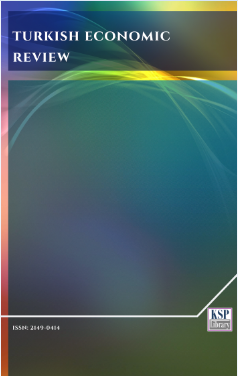Assessment of Climate Change on Sesame Cultivation in Makurdi Local Government Area of Benue State, Nigeria
Abstract
Abstract. The study was conducted to determine the assessment of climate change and ascertain the awareness among sesame farmers in Makurdi local government area of Benue state. A sample of 120 farmers participated in the study. Descriptive statistics and logit regression were used to analyse the data. The results shows that more male farmers (69.2%) within the age range of 21-40 years are involved in the production of sesame when compared to female farmers (30.8%). It was observed that most of the farmers are married (82.5%). The educational level is low among sesame farmers with most of them having only primary education (45%). The result also shows that most of the farmers have farming experience of less than 10years with a farm size of less than 4 hectares. Insect infestation, soil erosion is perceived as reasons for low yield. Sesame farmers have adapted to such changes through the use of improved seed varieties, use of chemicals and mixed cropping. Results also showed that extension agents, educated farmers and relatives were the major sources of information about climate change. It was also revealed that climate has little effect on sesame as the average yield of the crop is 57.5% compared to low yield of 13.3%, also socio-economic characteristics of the farmers do not have any significant effect on the awareness of climate change as only household size and age are statistically significant at 1% and 5% respectively. To improve farmers’ awareness on climate change, the study recommends that there should be improvement in newspaper and radio/television broadcast in other to sustain sesame production in the event of climate change.
Keywords. Agriculture, climate change, perception, sesame, sandy loam, Nigeria.
JEL. O12, O13, Q18.
References
Bellard, C., Bertelsmeier, C., Leadley, P., Thuiller, W., & Courchamp, F. (2012). Impacts of climate change on the future of biodiversity, Ecology Letters. 15(4), 365–377. doi. 10.1111/j.1461-0248.2011.01736.x
Benue State Executive Council, (2014). Members and special advisers, Library of Congress Africa Pamphlet Collection.
El Khier, M.K.S., Ishag, K.E.A., & Yaboub, A.E.A. (2008). Chemical composition and oil characteristics of sesame seed cultivars grown in Sudan. Research Journal of Agriculture and Biological Science, 4(6), 761-766.
Falusi, A.O. (2007). Segregation of genes controlling seed colour in sesame (Sesamum indicum linn.) from Nigeria, Africa Journal of Biotechnology, 6(24), 2780-2783. doi. 10.5897/AJB2007.000-2444
Fariku, S., Ndonya, A.E., & Bitrus, P.Y. (2007). Biofuel characteristics of beniseed (Sesamum indicum) oil. Africa Journal of Biotechnology, 6(21), 2442-2443.
Ghandi, A.P. (2009). Simplified process for the production of sesame seed (Sesamumindicum L.) butter and its nutritional profit. Asian Journal of Food and Agro-Industry, 2(1), 24-27.
Hansen, R. (2011). Sesame profile. [Retrieved from].
National Population Commission, (2006). Population Census Statistics, Abuja FCT.
Naturland, (2002). Organic farming in the tropic subtropics: Sesame, 21/07/11. [Retrieved from].
Nwalem, M.P., Ukpe, U.H., Djomo, R.F., & Dzever, D. (2016). Structure, conduct and performance of sesame farmers in Benue State, Nigeria, International Journal of Humanities Social Sciences and Education, 3(6), 31-35. doi. 10.20431/2349-0381.0306005
Nzioku, J.M., Mvoula-Tsieri, M., Ndangui, C.B., Pambou-Tobi, N.P.G., Kimbonguila, A., Loumouamou, B., Silou, T., & Desobry, S. (2010). Characterization of seed and oil of sesame (Sesamumindicum L.) and the Kinetics of Degradation of the Oil during heating. Research Journal of Applied Science, Engineering and Technology, 2(3), 227-232.
Oplinger, E.S., Putnam, D.H., Kaminski, A.R., Hanson, C.V., Oelke, E.A., Schulte, E.E., & Doll, J.D. (2007). Alternative Field Crops Manual: Sesame. [Retrieved from].
Oyegoke, O.O., Babarinde S.A., Akintola A.J., Fatoba, A.J., & Tona, G. (2014). Physicochemical properties of sesame oil and varietal susceptibilty to tribolium castaneum herbst (Coleoptera: Tenebrionidae), infestation, Journal of Environmental Science, Toxicology and Food Technology, 8(5), 40-44. doi. 10.9790/2402-08554044
Purseglove, J.W. (1996). Tropical Crops, Longman, London.
Royal Society and National Academy of Sciences, (2014). Climate change evidence and causes, an overview from the Royal Society and the US National Academy of Sciences. Accessed 15/16/2017. [Retrieved from].
Seibert, U. (2007). Languages of Benue State. Nigerian Languages. Department of Languages and Linguistics, University of Jos, Plateau State, Nigeria.
United States Agency for International Development, (2002). Overview of the Nigerian sesame industry.
The United States Agency for International Development Nigeria, Chemonics International Inc, Washington DC: USAID.
DOI: http://dx.doi.org/10.1453/ter.v4i2.1306
Refbacks
- There are currently no refbacks.
.......................................................................................................................................................................................................................................................................................................................................
Turkish Economic Review - Turk. Econ. Rev. - TER - www.kspjournals.org
ISSN: 2149-0414
Editor: [email protected] Secretarial: [email protected] Istanbul - Turkey.
Copyright © KSP Library




